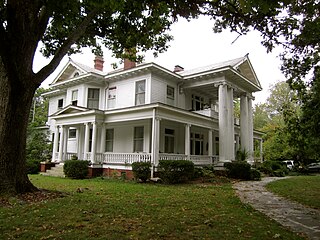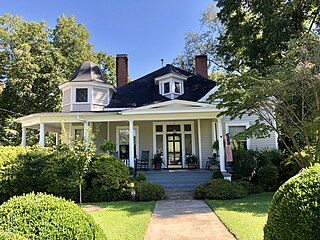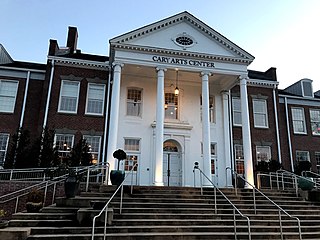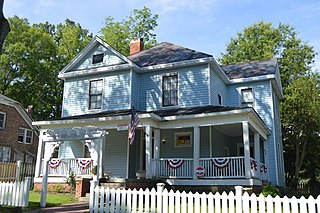
College Hill is a neighborhood in the west central section of the United States city of Greensboro, North Carolina. College Hill was Greensboro's first neighborhood.

The New Hill Historic District is a national historic district located at New Hill, North Carolina, an unincorporated community in southwestern Wake County. The district encompasses the commercial and residential center and includes 2,820 acres (11.4 km2), 59 buildings, and one structure. The district developed between about 1860 and 1950, and includes notable examples of Colonial Revival and Tudor Revival style architecture. Notable buildings include the W. T. Roundy commercial complex, C.J. Bright's general merchandise store or New Hill Emporium, W. T. Roundy House, Duncan Lashley House, John Bright House, New Hill Baptist Church, Glass-Gardner House, and several farm complexes.

The Central Troy Historic District is an irregularly shaped, 96-acre (39 ha) area of downtown Troy, New York, United States. It has been described as "one of the most perfectly preserved 19th-century downtowns in the [country]" with nearly 700 properties in a variety of architectural styles from the early 19th to mid-20th centuries. These include most of Russell Sage College, one of two privately owned urban parks in New York, and two National Historic Landmarks. Visitors ranging from the Duke de la Rochefoucauld to Philip Johnson have praised aspects of it. Martin Scorsese used parts of downtown Troy as a stand-in for 19th-century Manhattan in The Age of Innocence.

The Troy Village Historic District is a historic district encompassing the historic village center of Troy, New Hampshire, United States. The district is centered along New Hampshire Route 12, north to Marlborough Road and south to the junction with South Main Street. To the east of NH 12 it includes School Street, Mill Street, and Monadnock Street as far as Mill Street, and most of the abutting streets. On the west side it includes Russell, Water, and Prospect streets, and South Main Street nearly to Longmeadow Drive. It was listed on the National Register of Historic Places in 2002.

The Monroe Residential Historic District is a national historic district located at Monroe, Union County, North Carolina. It encompasses 376 contributing buildings, 1 contributing site, and 4 contributing objects in a predominantly residential section of Monroe. The district developed between about 1874 and 1940 and includes notable examples of Italianate, Queen Anne, and Classical Revival architecture styles and includes work by architects Wheeler & Stern and by G. Marion Tucker. Notable buildings include the R. V. Houston House, Houston-Redfearn House, the Belk House, J. H. Lee House, M. G. Sheppard House, Elizabeth Friedeman House, former Methodist Parsonage, Gaston Meares House, William E. Cason House, M. G. Sheppard House, and George B. McClellan House.
Linthicum & Linthicum was an architectural firm in North Carolina. It was a partnership of Hill Carter Linthicum (1860-1919) who was a prolific architect, and H. Colvin Linthicum, his son.

Matson Street Historic District is a national historic district located at Kershaw, Lancaster County, South Carolina. It encompasses 26 contributing buildings in a residential section of Kershaw. The majority of the buildings date from about 1890 to 1940, a particularly significant period of development in Kershaw. The houses are in a variety of representative architectural styles include Victorian, Queen Anne, Bungalow, American Craftsman, Colonial Revival, and Neo-Classical. Also located in the district is the First Presbyterian Church.

South Broad–East Fifth Streets Historic District is a national historic district in Burlington, Alamance County, North Carolina. It encompasses 108 contributing buildings in a primarily residential section of Burlington. Most of the buildings are houses, one to two stories high, built between the 1890s and the 1940s in late Victorian, Queen Anne, American Craftsman, and Colonial Revival styles of frame or brick construction.

Washington Historic District is a national historic district located at Washington, Beaufort County, North Carolina. It encompasses 512 contributing buildings and one contributing structure in the town of Washington. They include a variety of institutional, commercial, and residential buildings primarily dating from the late 19th and early 20th centuries. Notable buildings include the Beaufort County Courthouse, Havens and Fowle warehouses, Mayo Law Office, Marsh House, Myers House, Hyatt House, Griffin House, Rodman House, Elmwood, Firehouse and City Hall, Post Office and Federal Courthouse (1913), railroad station, Presbyterian church, Saint Peter's Episcopal Church, First Methodist Church (1899), Singleton Primitive Baptist Church, Blount-Bragaw Building (1901-1904), Minor House, and George T. Leach House.

Southport Historic District is a national historic district located at Southport, Brunswick County, North Carolina. The district encompasses 161 contributing buildings, 3 contributing sites, and 1 contributing object. Over half of the structures in the historic district date from the 1885-1905 period. It includes residential, commercial, and institutional buildings and is considered the best example of a Victorian coastal town in North Carolina. Notable buildings include the River Pilots Tower and Building (1940s), Frying Pan Lightship, Fort Johnston Officers Quarters, Walker-Pike House, Brunswick Inn, Fort Johnston Hospital, Former Brunswick County Court House, Saint Philips Episcopal Church, Trinity Methodist Church (1888-1890), and the Adkins-Ruark House (1890).

West Union Street Historic District is a national historic district located at Morganton, Burke County, North Carolina. It encompasses 59 contributing buildings in a predominantly upper class residential section of Morganton. They were built between about 1815 and 1940, with the majority built between about 1890 and 1938. The district includes representative examples of Queen Anne, Colonial Revival, Bungalow / American Craftsman, and Late Victorian style architecture. Located in the district and listed separately is the Franklin Pierce Tate House.
East Durham Historic District is a national historic district located at Durham, Durham County, North Carolina. The district encompasses 731 contributing buildings and 1 contributing site in a predominantly residential section of Durham. The buildings primarily date between about 1890 and 1955 and include notable examples of Classical Revival and Queen Anne architecture. Notable buildings include the Holloway Street School (1928), East Durham Junior High School, Advent Christian Church (1920s), John Cheek House (1899), Community Groceries (1900), George Brown Grocery Store (1920), Seagroves Grocery Store (1915), and The People's Bank (1921).

Trinity Historic District, also called Trinity Park, is a national historic district and residential area located near the East Campus of Duke University in Durham, North Carolina. The district encompasses 751 contributing buildings in a predominantly residential section of Durham. They were built between the 1890s and 1960 and include notable examples of Queen Anne and Bungalow / American Craftsman style architecture. Located in the district are the separately listed "Faculty Row" cottage: the Bassett House, Cranford-Wannamaker House, Crowell House, and Pegram House. Other notable buildings include the George W. Watts School (1917), Julian S. Carr Junior High School (1922), Durham High School (1923), Durham Alliance Church (1927), Trinity Presbyterian Church (1925), Great A & P Tea Company (1927-1929), Grace Lutheran Church, and the former Greek Orthodox Community Church.
Tarboro Historic District is a national historic district located near Tarboro, Edgecombe County, North Carolina. The district encompasses 364 contributing buildings in central Tarboro. It includes a variety of industrial, commercial, residential, and institutional buildings dating from the late-18th through early-20th centuries. Located in the district are the separately listed Tarboro Town Common, The Barracks, Redmond-Shackelford House, Pender Museum, Blount-Bridgers House, Coates-Walston House, Calvary Episcopal Church and Churchyard, and the Cotton Press complex. Other notable buildings include the Morris-Powell House, Porter House, U. S. Post Office (1914), Pippen House (1870s), Dancy-Battle-Bass Clark House, Holderness House, Howard Memorial Presbyterian Church (1908-1909), W. H. MacNair House (1913), Henry Cherry-George White House, Jones House (1870-1875), Tarboro Primitive Baptist Church, St. James Methodist Church (1916), Carolina Telephone & Telegraph (1912), Clark's Warehouse #1 and #2, Battle-Porter-Powell House, Gaskil1-Hussey House (1882), Cheshire-Nash House, and Norfleet Court (1858).
Mill Avenue Historic District is a national historic district located at Jacksonville, Onslow County, North Carolina. The district encompasses 31 contributing buildings, 1 contributing site, and 1 contributing structure in a predominantly residential section of Jacksonville. The district developed after 1890 and includes notable examples of Late Victorian and Bungalow / American Craftsman style architecture. Notable contributing buildings include the Jarman Hotel, Jacksonville Depot, Richard Ward House, Richard Ward Guest House, the Lockamy-Chadwick House, George Bender House (1901), Samuel Ambrose House, the Marine House, Steve Aman House, and the Henrietta Jarman House.

Richlands Historic District is a national historic district located at Richlands, Onslow County, North Carolina. The district encompasses 90 contributing buildings, 2 contributing structures, and 2 contributing objects in the central business district and surrounding residential sections of Richlands. The district largely developed after 1880 and includes notable examples of Late Victorian and I-house style residential architecture. Notable contributing buildings include the Robert D. Thompson House (1908), Daniel Webster Murrill House (1908), the Del Barbee House (1910), the Edwards-Cox House (1915), Isaac Koonce House (1918), George Brooks House (1915), Franck House (1914), Richlands Theater (1936), J. F. Mohn Building (1936), Richlands Supply Company Building (1905), M. B. Steed Store (1911), Peoples Bank Building, Bank of Richlands (1927), First Baptist Church (1920s), and Richlands United Methodist Church (1939).

North Long Street–Park Avenue Historic District is a national historic district located at Salisbury, Rowan County, North Carolina. The district encompasses 46 contributing buildings in a predominantly residential section of Salisbury. It was developed largely between about 1890 and 1925, and includes notable examples of Gothic Revival, Colonial Revival, and Bungalow / American Craftsman style. It was listed on the National Register of Historic Places in 1985.

Cary Historic District is a national historic district located at Cary, Wake County, North Carolina. The district encompasses 39 contributing buildings in a predominantly residential section of Cary. The district developed between about 1890 and 1945, and includes notable examples of Queen Anne and Bungalow / American Craftsman style architecture. Notable buildings include the former Cary High School built in 1939 by the Works Progress Administration, Esther Ivey House, Captain Harrison P. Guess House, and Dr. John P. Hunter House.

Plymouth Historic District is a national historic district located at Creswell, Washington County, North Carolina.

Broad–Kenan Streets Historic District is a national historic district located at Wilson, Wilson County, North Carolina. It encompasses 293 contributing buildings in a predominantly residential section of Wilson. The district developed between about 1890 to 1940 and includes notable examples of Colonial Revival, Bungalow / American Craftsman, and Queen Anne style architecture. Notable buildings include the Woman's Club of Wilson (1922).



















